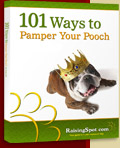Two Tips for Housebreaking Your Puppy
Trouble knowing when you puppy needs to go outside? Teach the dog to ring a bell hanging from your doorknob when he wants out. It sounds incredible but really isn’t hard to do. I use a cowbell because it is loud enough to hear from all over the house. You can usually find them at feed stores or farm supply stores.
Hang the bell from the door knob so it is about eye level with your puppy. When you are ready to take your puppy out, gently take his paw and swat the cowbell so it makes noise. Tell the puppy, “good out,” and open the door for him. Repeat this every time before you let the puppy out.
Soon, the puppy will be running up to the bell and ringing it to go out. You must drop whatever you are doing and let the puppy out immediately. Tell them, “good out,” as you open the door.
One caution about this method: when the puppy first learns that ringing the bell makes the door open, he will ring the bell just to see if you will open the door. This stage only lasts a week or two, but it is very important that you continue opening the door every time the puppy asks so they will continue asking when they really need out. This is a small inconvenience in the grand scheme of things and giving the puppy a way to ask to go out really speeds up housebreaking. Your puppy may still have a few accidents, so you must still supervise him any time he is loose in the house, but the accidents will be much less prevalent with this method of housebreaking than most other methods.
A second tip that helps with housebreaking is to teach your puppy to go on command. This tells the dog, in effect, that it is now or never and to hurry up. Traveling with a dog is much easier when you can convey this message and do not have to keep stopping to let the dog out.
Every time you let your puppy out, walk him on leash. When the puppy goes, tell them, “good potty” or whatever command word you want him to go on. After a couple of weeks of doing this religiously, the dog will have caught on that “potty” means relieve himself.
Now you can start to use the command word to indicate your desire for the dog to go as well as praise him when he does. When you take the dog out to his potty area, tell the dog “go potty.” As soon as the dog relieves himself, tell him “good potty.” Soon the dog will associate the command with the idea of relieving himself.
This command takes longer to learn than some commands because you cannot compel the dog to relieve himself, but must take advantage of the times when he does to reinforce the command. However, persistence will teach the dog the meaning of the commands and will enable you to tell the dog he is expected to relieve himself now.




Comments